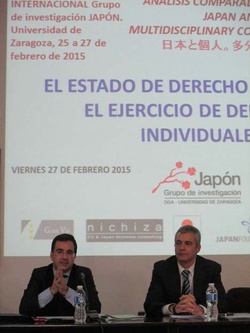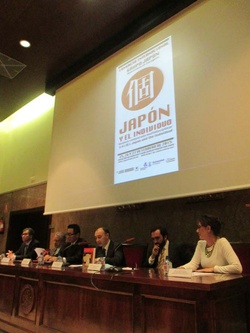At the end of February this year, I visited the University of Zaragoza in Spain to participate in an academic conference. The university has a "Japanese Studies Group" that focuses on law, literature, and other subjects, and is enthusiastically researching Japan. Many students have mastered the Japanese language, and there is also an exchange program with Japanese universities. The theme of the conference was "Japan and the Individual: Comparative Analysis Across Multiple Fields," and researchers and graduate students from universities across Spain participated, with five people from Japan, including myself, having the opportunity to give a presentation.1 The opening ceremony was also attended by the university's senior officials, the Japanese ambassador to Spain, Koshigawa, and Ueno, then director of the Japan Foundation Madrid office. The Foundation also provided financial support for the conference, which enabled us to rush over from Japan.

One of the key members of this research group, lawyer, legal consultant and Japanese language teacher Francisco Barberán, studied Japanese on his own and is now one of the world's most authoritative legal translators. He is known to everyone involved in Japanese and Spanish law, or Latin American law, due to his efforts in publishing such books as "Seiwa-Seiwa Legal Dictionary," "Introduction to Modern Spanish Law," and "Introduction to Modern Japanese Law (Spanish version). "2 I, too, learned a lot from the opportunity to contribute, however small, to a chapter in "Introduction to Spanish Law and Japanese Law."
However, in the world of law, even if there is a dictionary of technical terms, there are many cases where literal translation is not possible, and free translations and detailed annotations are required depending on the interpretation and scope of the law, the intent of the provisions, and the operation of the judicial system. There are times when explanations can feel limited, and translation or interpretation must be done carefully, taking into account the country's legal system, customs, social structure, and political background. Barberan is also well-versed in Japanese legal philosophy and history, and when I listened to his lectures at Sophia University during his visit to Japan last year, I was reminded of my own lack of experience.
At this conference, I gave a presentation titled "Japan's Labor Market: Workers as Individuals." I spoke from the perspective of how Japan's individual labor relations are not doing enough to protect individual workers, the differences and disparities between regular and non-regular employees that are currently a hot topic, the situation of non-regular employees and their low union membership rate, long working hours and an increase in mental illnesses (suicides due to overwork, etc.) for regular employees, and the high employment rate for university graduates and the mismatch between employment opportunities.
Spain currently has a high unemployment rate of 23%, unimaginable in Japan, and the youth unemployment rate is as high as 50%, meaning that one in two people are unemployed. The economy is gradually recovering thanks to structural reforms, and new jobs are being created, but many jobs are short-term or non-regular, and there are still concerns. The Ministry of Finance estimates that the underground economy is about 25%, and many unemployed people are making a living by running their own businesses. This rate is double that of major EU countries such as Germany, France, and the UK, and it is not possible to know what kind of work people are doing or how much they are earning, and it is not possible to collect taxes or social insurance premiums.
Meanwhile, as of January 1st of this year, the number of registered foreigners was 4.7 million, a decrease of 6.1% from the previous year (in 2011, the number had risen to 5.2 million, making up 12% of the total population). The largest decline was among those from Latin America, with Peruvians dropping by 21.3%, Ecuadorians by 19.5%, and Colombians by 17%. Romanians and Moroccans, who are the largest communities in terms of numbers, also struggled to find work, and even when they did, it was on a non-regular basis. At the same time, it has been pointed out that the number of foreigners living in poverty has increased significantly (the national average is 27.3%, but a survey conducted three years ago, when the economic crisis was at its most severe, estimated the poverty rate for foreign immigrants to be 47% 3 ).
When talking with Spaniards, a topic that comes up recently is the migration of university graduates and young people with a certain level of skills from Spain to Latin American countries4 . In just the past few years, hundreds of thousands of people have temporarily emigrated to Brazil, Argentina, Colombia, Chile, Peru, etc., but according to the International Organization for Migration (IOM), a United Nations organization, 180,000 people migrated from Europe to Latin American countries in 2012, of which 150,000 were from Spain. The number of people from Italy and Portugal is actually decreasing, but due to the economic upswing in Latin America and a shortage of engineers, marketers, financial and accounting personnel in some industries, there is a high demand for Spaniards who can communicate in the same language. On the other hand, depending on the type of job, migration within Latin America is also active, with Peru, Bolivia, Ecuador, etc. being quite popular.
In any case, during my visit to Spain I could see signs of economic recovery in both Zaragoza and Madrid, and I couldn't help but hope that employment would improve, even if only gradually.
After that, I went on a personal trip to visit an acquaintance, a social scientist from Argentina, who lives in Clermont-Ferrand in the southeast of France. I spent three days in the quiet countryside before moving to Paris. My graduate school classmates and students live there, so they took me to not only the city's tourist attractions, but also to the Indian and African immigrant neighborhoods. Although it had been more than three months since the terrorist attack on the headquarters of the satirical weekly newspaper Charlie Hebdo, the soldiers' security did not seem very tense.
In France, 6.5 million people, or 10% of the total population, are foreign immigrants, and the number of Muslims, who are of multiple nationalities, runs into the millions. In terms of population ratio, this is about the same as Spain, but in both countries, more than 100,000 foreigners are naturalized each year, so the pace of legal integration is faster. However, the acquisition of visas, the number of family members brought over, and the frequency of crackdowns on illegal immigrants and deportations are all somewhat influenced by the economic situation and the government's foreign immigration policy. There is some discussion about the burden (cost) of accepting immigrants, given the large number of immigrants, but their contribution is also evaluated based on fairly objective indicators.
Since there are many young immigrants, statistics are published on the labor provided to fill labor shortages, the amount of taxes and social insurance premiums collected from that labor, and the contribution to the birth rate, etc. However, the recent increase in refugees and immigrants from unstable or conflict-ridden countries in the Middle East and North Africa has raised concerns and alarm in all societies, and in some places, expressions of exclusion and racism are prominent.
During this trip, I also felt that it was becoming increasingly difficult to maintain the ideals of "Liberty, Equality, Fraternity" that are inscribed on the walls of every school in France.
Notes:
1. JAPON Research Group , University of Zaragoza
2. Professor Barberan's consulting company: http://www.nichiza.com
Publications: http://www.derecho-hispanico.net/libros.html
3. “ The nemesis of immigrants lives in Spain, at the border of the poor ”, El Mundo , 28.11.2011.
4. " What is migration from Europe to Latin America? " (Discover Nikkei, July 2013)
© 2015 Alberto J. Matsumoto









